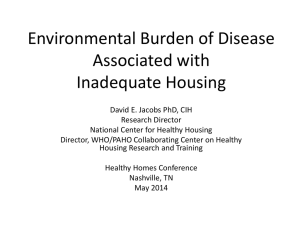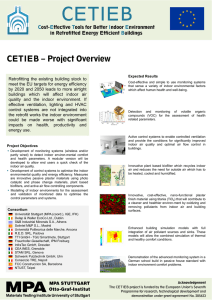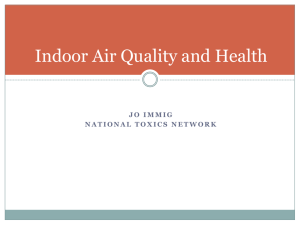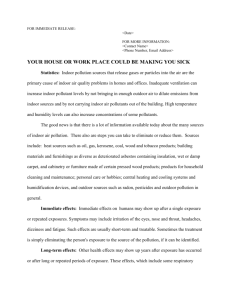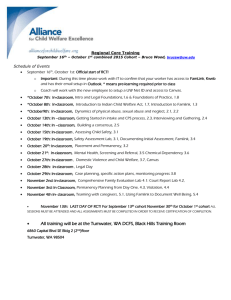Recommended School Administrator or Principal Policy Statement
advertisement
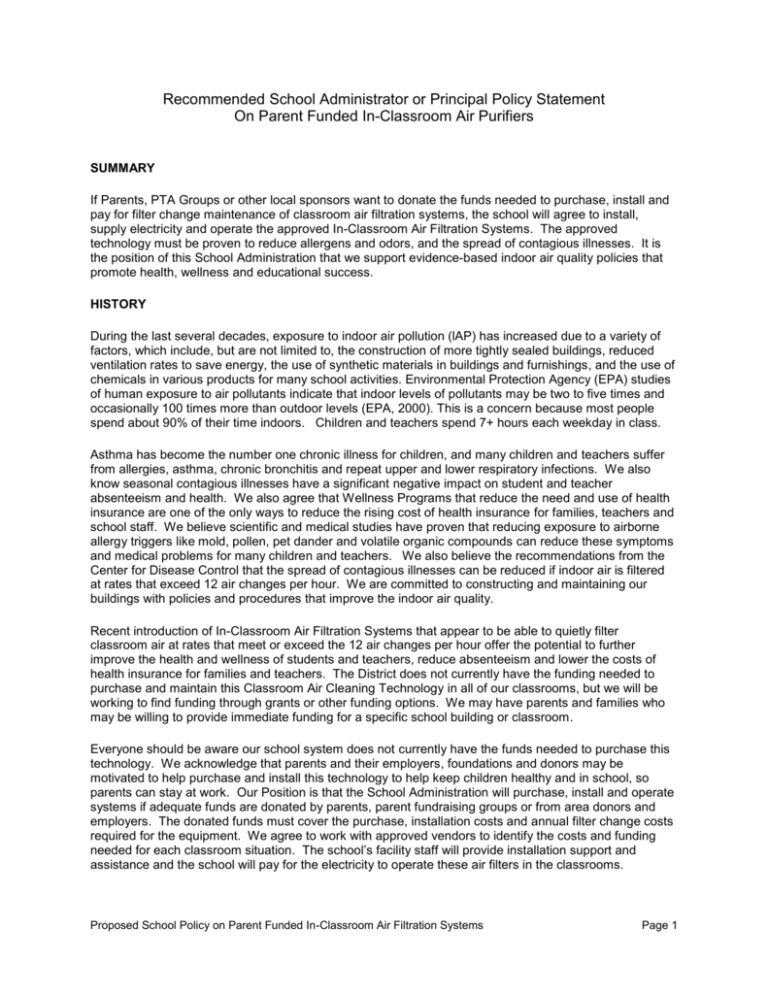
Recommended School Administrator or Principal Policy Statement On Parent Funded In-Classroom Air Purifiers SUMMARY If Parents, PTA Groups or other local sponsors want to donate the funds needed to purchase, install and pay for filter change maintenance of classroom air filtration systems, the school will agree to install, supply electricity and operate the approved In-Classroom Air Filtration Systems. The approved technology must be proven to reduce allergens and odors, and the spread of contagious illnesses. It is the position of this School Administration that we support evidence-based indoor air quality policies that promote health, wellness and educational success. HISTORY During the last several decades, exposure to indoor air pollution (lAP) has increased due to a variety of factors, which include, but are not limited to, the construction of more tightly sealed buildings, reduced ventilation rates to save energy, the use of synthetic materials in buildings and furnishings, and the use of chemicals in various products for many school activities. Environmental Protection Agency (EPA) studies of human exposure to air pollutants indicate that indoor levels of pollutants may be two to five times and occasionally 100 times more than outdoor levels (EPA, 2000). This is a concern because most people spend about 90% of their time indoors. Children and teachers spend 7+ hours each weekday in class. Asthma has become the number one chronic illness for children, and many children and teachers suffer from allergies, asthma, chronic bronchitis and repeat upper and lower respiratory infections. We also know seasonal contagious illnesses have a significant negative impact on student and teacher absenteeism and health. We also agree that Wellness Programs that reduce the need and use of health insurance are one of the only ways to reduce the rising cost of health insurance for families, teachers and school staff. We believe scientific and medical studies have proven that reducing exposure to airborne allergy triggers like mold, pollen, pet dander and volatile organic compounds can reduce these symptoms and medical problems for many children and teachers. We also believe the recommendations from the Center for Disease Control that the spread of contagious illnesses can be reduced if indoor air is filtered at rates that exceed 12 air changes per hour. We are committed to constructing and maintaining our buildings with policies and procedures that improve the indoor air quality. Recent introduction of In-Classroom Air Filtration Systems that appear to be able to quietly filter classroom air at rates that meet or exceed the 12 air changes per hour offer the potential to further improve the health and wellness of students and teachers, reduce absenteeism and lower the costs of health insurance for families and teachers. The District does not currently have the funding needed to purchase and maintain this Classroom Air Cleaning Technology in all of our classrooms, but we will be working to find funding through grants or other funding options. We may have parents and families who may be willing to provide immediate funding for a specific school building or classroom. Everyone should be aware our school system does not currently have the funds needed to purchase this technology. We acknowledge that parents and their employers, foundations and donors may be motivated to help purchase and install this technology to help keep children healthy and in school, so parents can stay at work. Our Position is that the School Administration will purchase, install and operate systems if adequate funds are donated by parents, parent fundraising groups or from area donors and employers. The donated funds must cover the purchase, installation costs and annual filter change costs required for the equipment. We agree to work with approved vendors to identify the costs and funding needed for each classroom situation. The school’s facility staff will provide installation support and assistance and the school will pay for the electricity to operate these air filters in the classrooms. Proposed School Policy on Parent Funded In-Classroom Air Filtration Systems Page 1 DESCRIPTION OF ISSUE Indoor air quality problems can be subtle and do not always produce easily recognizable impacts on health, well-being, or the physical plant. Children may be especially susceptible to lAP. They have a smaller body mass than adults and breathe a greater volume of air relative to their body weight (EPA, 2000). The concentration of pollutants can, therefore, result in a greater body burden for children. Proper maintenance of indoor air is more than a "quality" issue. It encompasses safety and stewardship of our investment in the students, staff, and facilities. Factors affecting indoor air quality include indoor air pollutants, such as mold and animal dander, heating ventilation/air-conditioning systems, all materials and supplies used for educational activities and building maintenance, and building occupants. EPA risk studies have consistently ranked lAP among the top five environmental health risks to the public. The National Association of School Nurses has reported: (September 10, 2003, Oakland, CA) According to a national sample of members surveyed from the National Association of School Nurses (NASN), asthma is more disruptive of school routines than any other chronic condition, has a significant impact on absenteeism and many school staff may lack awareness of the causes of an asthma attack. The NASN and the American Lung Association are working together to improve communications between parents, school nurses and health care professionals in an effort that may help reduce the number of asthma episodes or attacks children experience each year. Results from the Asthma in Schools survey suggest that an overwhelming majority (85 percent) of school nurses believe that there are students with undiagnosed asthma in their schools. More than half found asthma more disruptive to the student body routine than any other chronic health condition, with more than a third of nurses having to respond to an acute asthma attack or episode at least 11 times in the last school year. See http://www.californialung.org/press/030909asthma.html We believe incentives for improving Indoor air quality would include: Increased student and teacher attendance levels by reducing sick days Increasing Average Daily Attendance (ADA) can boost school funding A better teaching environment with less coughing, sneezing, nose blowing and disruptions Reduced need for inhalers, breathing treatments and other allergy and asthma medications Less respiratory stress on teachers primary teaching tool, their voice Improved concentration, less medication and fewer sick days should increase test scores Reduced risk of asthma attacks in children and school staff Reduce classroom levels of exhaust particles from diesel engines or near-by high traffic areas Reduced the airborne spread of contagious seasonal colds and flu type illnesses Reduced health care costs and missed work costs for families and teachers Lower health insurance usage may lower future health insurance care costs Reduced substitute teacher costs A decrease in the potential for short-term and long-term health problems for students and staff Greater comfort, health, academic performance, and attendance Increased productivity of teachers and staff due to less discomfort, sickness, and absenteeism A healthier classroom could help with teacher retention and recruiting which is becoming more important in many school districts struggling to retain and recruit teachers. Less deterioration and improved efficiency of the school physical plant and equipment Less potential for school closures and relocation for renovations and repairs Better relationships among school administration, staff, teachers, parents, and students Positive publicity affecting the school efficacy and image Reduce the potential liability for health problems or asthma attack issues creating a financial significant financial impact on the school district Additionally, environmental quality is one of ten health indicators used in Healthy People 2010 (DHHS, 2000). http://www.healthypeople.gov/ Proposed School Policy on Parent Funded In-Classroom Air Filtration Systems Page 2 RATIONALE Classroom or school building Indoor Air Quality is influenced by a wide variety of sources for airborne allergy triggers, bacterial and viral illnesses and other known airborne pollutants, gasses, odors and particles. While building issues like water damage and mold may have some impact on these issues, significant quantities of these particles arrive every day in the outdoor air, and on the clothes, hair, skin, shoes and backpacks of the students and teachers when they arrive in the room. These students and teachers also bring in contagious viral and bacterial illnesses that can be spread to others in the room through airborne droplet transmission. Since you cannot eliminate the students, teachers or Mother Nature’s seasonal airborne pollen and mold, one viable solution is effective, powerful in-classroom air filtration. In-classroom air filtration system that filter the air more than 12 air changes per hour appear to have significant positive benefits on reducing the symptoms and health issues associated with high levels of airborne particles, allergens or pollutants. It also appears this high-level of air filtration may reduce the airborne spread of contagious viral or bacterial based illnesses. So installing high-capacity in-classroom air filtrations system is a justifiable way to try to improve the many negative issues that appear to be caused by these airborne pollutants and contagious illnesses. APPROVED TECHNOLOGY SYSTEMS The vendors and approved systems may change over time, but typically the approved technology must be very quiet, energy efficient, easy to install and produce 12 or more classroom air changes per hour. We want evidence-based proof of performance including particle counts, in-school trials and references. REFERENCES AND RESOURCES EPA Position Paper – Indoor Air Quality & The Impact on Student Performance – http://epa.gov/iaq/schools/pdfs/publications/iaq_and_student_performance.pdf National Association of School Nurses – 2003 NASN Survey Reported Many Children Have Undiagnosed Asthma http://www.californialung.org/press/030909asthma.html Environmental Law Institute. (2004, May). Database of state indoor air quality laws [Excerpt IAQ in Schools]. Washington, DC: Author. Available at www.eli.org/pdf/schools_excerpt.pdf National Safety Council. Environmental Health Center. (2000). Teachers guide to indoor air pollutants. Storey, E., Dangman, IK., Schenck, P., et al. (2004). Guidance for clinicians on the recognition and management of health effects related to mold exposure and moisture indoors. University of Connecticut Health Center, Division of Occupational and Environmental Medicine, Center for Indoor Environments and Health. U.S. Department of Education. (2004). Summary of scientific findings on adverse effects of indoor environments on students’ health, academic performance and attendance. Available at http://www.iehinc.com/pdf/Effects%20on%20Students.pdf U.S. Environmental Protection Agency (EPA). (2000). Tools for schools: Indoor air quality. http://www.epa.gov/iaq/schools/tools4s2.html Indoor Air Quality Symposium Presentations – www.iaqsymposium.com EPA Tools for Schools - Envisioning Excellence Program - http://www.iaqsymposium.com/envisioningexcellence.html Note: This sample recommended policy was developed from published material and indoor air quality policies on websites including the EPA, CDC, National School Board Association, American Association of School Administrators, National Association of Elementary School Principals, American Lung Association, Allergy and Asthma Foundation, National Association of School Nurses, American Federation of Teachers, United Teacher Federation and National Education Association. Proposed School Policy on Parent Funded In-Classroom Air Filtration Systems Page 3
